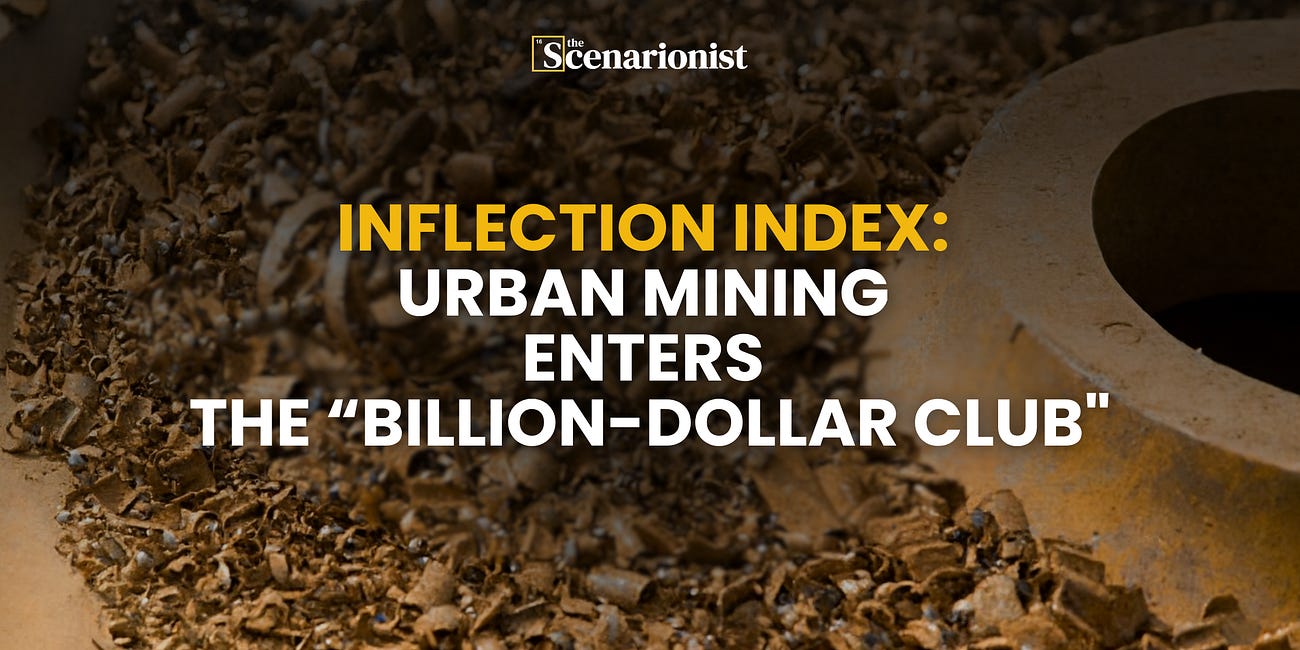Welcome to the 97th edition of Deep Tech Catalyst, the educational channel from The Scenarionist where science meets venture!
Biomanufacturing is entering a decisive phase. Once a frontier of synthetic biology, it now stands at the intersection of engineering, automation, and industrial scale. The challenge is no longer whether biology can make things, but whether it can make them competitively, at volumes that matter.
How do Deep Tech founders navigate the shift from the lab bench to industrial production?
To explore what it truly takes to build scalable biomanufacturing companies, we’re joined by Nima Ronaghi, Principal at Breakout Ventures!
Key takeaways from the episode (TL;DR):
🧫 Identify, Engineer, Produce
Success in biomanufacturing begins with the right organism, refined for speed, cost, and stability, and proven at scale.
⚙️ Continuous Fermentation Is Gaining Ground
Advances in process control and automation are enabling steady-state, modular production that lowers CapEx and localizes output.
💡 Sell the Product, Not the Method
Synthetic biology is an enabler, not a business model. Viability depends on cost and performance, not on scientific novelty.
📉 Scale Myths Persist
The real cost bottleneck is downstream; capacity is scarce, and premature scale destroys optionality.
📊 Economics Defines Endurance
Productivity, yield, and purity drive unit costs; disciplined scaling builds margin before expansion.
🏭 Build Capacity Intelligently
Use contract manufacturing first to validate demand, then invest in owned production once economics and customers align.
✨ For more, see Membership | Deep Tech Briefing | Insights | VC Guides
BEYOND THE CONVERSATION — STRATEGIC INSIGHTS FROM THE EPISODE
Find the Bug, Engineer the Bug, Produce What You Engineered
Effective biomanufacturing begins with selection. The objective is not to invent capability from scratch but to identify an organism whose native metabolism already aligns with the intended outcome.
Nature’s repertoire—enzymes, pathways, and regulatory circuits—offers starting points that can accelerate development if chosen well. Selecting the “right bug” is therefore a strategic decision that shapes the entire program.
It determines the direction of optimization, the likely constraints, and the level of effort required downstream.
Projects that begin with a chassis predisposed to the target function consistently progress with fewer surprises and clearer cost trajectories.
Rewiring for Speed, Cost, and Stability
Once the organism is defined, the work becomes one of disciplined engineering. The mandate is to reconfigure metabolism so the desired product is formed faster, at lower cost, and with greater reliability than it would occur in nature.
The modern toolkit—CRISPR and related editing methods, complemented by computational and AI-enabled design—has materially shortened the cycle from hypothesis to construct.
Yet the standard for success is not a schematic or a data point from a single run; it is stable performance over time. A viable strain delivers consistent output and resists evolutionary drift, sustaining its profile across operating conditions that resemble those of production rather than the bench.
Why Scale Is the Real Test
The decisive proof is production at scale. Laboratory quantities demonstrate the possibility; industrial quantities determine the viability.
As processes move from flask to pilot to plant, the realities of oxygen transfer, heat management, residence time, and downstream recovery surface in full.
This is where the sector’s imbalance is most evident.
Tools for discovering organisms and editing genomes have advanced rapidly, while the translation of those gains into robust, economic tonnage remains the hardest problem to solve.
Ultimately, biomanufacturing is validated not by a sequence but by a process capable of delivering consistent, cost-aware volumes. When that translation holds, the scientific concept becomes an operating business.
Power-to-compute leads global raises; Autonomy funds real missions; Chemistry gets paid to go autonomous & more | Deep Tech Capital Movements #41
This week's Deals Sector Allocation — Energy 9; AI & Compute 6; AgTech & Food 7; Manufacturing 4, Cyber & Defense 5; Biotech 4; Semis & Quantum 3, Mobility & Logistics 3; Materials 2; Space & Aero 1.
Why Continuous Fermentation Is Rising Now
In batch fermentation, a vessel is inoculated, allowed to run for hours or days, then stopped for harvest and cleaning before the next run begins. The cycle is labor-intensive, discontinuous, and difficult to automate end-to-end.
Continuous fermentation replaces that stop-start rhythm with a controlled steady state. Fresh media is introduced while culture is simultaneously removed, sustaining exponential growth and creating a more constant production environment.
The shift is not merely operational. It redefines how capital and labor are used, how uptime is managed, and how predictable the output can become when the process is under control.
The Hard Part: Control, Contamination, and Drift
The challenge has never been in articulating the benefits of continuous processing; it has been in maintaining the conditions that make those benefits real. Tight feedback loops on pH, dissolved oxygen, temperature, and metabolite accumulation must hold within narrow bounds for extended periods.
Contamination risk is ever-present in biology in a way that it’s not in traditional chemical flow processes. Strains evolve; without careful design and monitoring, evolutionary drift can pull performance away from the intended product.
Finally, most facilities were not built with the infrastructure required for true continuous operation, creating a practical gap between aspiration and implementation.
The question is not capacity in the abstract but whether a given plant has the specific capabilities, tooling, and know-how to run continuous fermentation for a particular product and downstream sequence.
What’s Different Today: Software, Process Control, and Smaller-CapEx Plants
Several conditions have improved in tandem. Process control has advanced, with more sophisticated sensing and automation making it feasible to sustain steady-state operation.
A new wave of companies is addressing the software layer of biomanufacturing—integrating data, controls, and optimization across scale-up and downstream, rather than treating them as isolated steps.
Strain design is more stable than it was a decade ago, reducing the drift that undermined long runs. Downstream costs are coming down, and capital can be leveraged into smaller-footprint plants that would have been uneconomic before.
These developments do not remove the difficulty, but they materially change the starting position for teams attempting continuous operation.
Modular and Distributed Production as a Strategic Fit
Continuous fermentation also aligns with modular, distributed biomanufacturing. Smaller, more automated units can be replicated and situated closer to demand, enabling localized production that was not practical ten years ago.
The combination of improved control systems and lower site-level CapEx opens a path to scale that does not depend on a single, monolithic facility.
Where It Applies in Practice
The relevance spans categories where economics are sensitive to cost and throughput. In pharmaceuticals, higher prices can absorb greater process complexity, so the cost pressure is different.
In chemicals and materials, the picture changes.
Inputs for adhesives, chemical starting materials, pigments, and even complex vitamins such as B12 compete in markets where price discipline is strict.
For these products, the ability to run closer to steady state with consistent quality can influence unit economics in ways that intermittent batch processing struggles to match.
The case for continuous fermentation strengthens wherever volumes are meaningful and margins depend on efficient, reliable conversion at scale.
Sell the Product, Not the Toolkit
A recurring misconception in industrial biotechnology is that synthetic biology itself is a business category. In practice, it is an enabling method—a set of tools applied to a specific commercial purpose.
For instance, a company producing vitamin B12 through engineered microbes is not a “synthetic biology company.” It is a vitamin B12 company that uses synthetic biology as its manufacturing platform. The distinction is more than semantic; it defines how the company tells its story, who its customers are, and how investors evaluate it.
Markets ultimately buy outcomes, not processes.
Buyers care about the quality, cost, and performance of the final molecule or material, not the biological elegance behind it. The more founders frame their work around the market they serve—nutrition, specialty chemicals, materials, or health—the clearer their path to scale becomes.
As the sector matures, investor discipline is moving in the same direction: evaluation based on market traction and cost trajectory rather than novelty of the toolkit.
Pricing Power and What That Means for COGS
The economics of biomanufacturing are deeply shaped by where a product sits on the value spectrum. In pharmaceuticals, prices are high and cost sensitivity is low.
A biologic drug can tolerate expensive fermentation and purification steps because its selling price is orders of magnitude higher than its cost of goods. In contrast, most chemicals and materials are priced as commodities.
Adhesives, pigments, vitamins, and chemical precursors sell into markets where margins are thin and customers are unwilling to absorb price increases.
For these categories, cost discipline defines viability. The difference between profitability and failure can rest on small percentage changes in yield or downstream recovery.
Every point of inefficiency compounds across production volumes.
In such environments, the production method—biological or otherwise—is judged entirely by its ability to meet cost and quality thresholds.
That is why the most competitive industrial biotech ventures position themselves not as demonstrations of synthetic biology, but as producers of essential, price-aware goods that happen to be made more efficiently through biology.
Ultimately, credibility in biomanufacturing is earned not through the sophistication of the science but through the clarity of the commercial proposition. The winning narrative is not about the method—it is about the market.
3 Myths That Derail Industrial Scale
Myth 1: Biology Is the Cost Bottleneck
The instinct in industrial biotechnology is to focus on strain engineering as the primary lever for economics. Better enzymes, tighter pathways, smarter edits—surely that is where the cost unlock resides.
In practice, the largest share of cost frequently sits downstream.
Purification and processing often account for a substantial portion of the total cost of goods, rising from a third to well over half, depending on the product and the complexity of the cleanup. When purity thresholds are stringent or byproducts are numerous, the burden compounds quickly.
Again, pharmaceutical biologics can absorb that complexity because selling prices are high; industrial molecules cannot. An antibody can sustain elaborate capture and polishing steps because the value per kilogram is measured in the tens of thousands.
A vitamin such as B12, priced orders of magnitude lower, cannot carry the same overhead. The conclusion is not that upstream work is trivial—it is essential—but that a credible economic model requires early, disciplined attention to the downstream sequence that will exist at scale, not just at bench.
Myth 2: Capacity Is Plentiful If You Scale Fast
A second misconception is that capacity is primarily a matter of finding open tanks. The United States remains underbuilt for industrial-scale biomanufacturing, and many existing contract facilities are designed around pharmaceutical needs rather than commodities.
Overbooking is common, but even when a slot appears, the decisive issue is capability rather than volume. A plant must possess the specific tooling, process understanding, and team to execute both the fermentation and the purification you require.
Producing an intermediate is not the same as delivering a saleable specification.
If a facility lacks the downstream operations your product demands, the apparent capacity is illusory.
The practical question is therefore narrower: who can run this exact process, end to end, with the right controls and the right recovery steps, reliably enough to meet cost and quality targets?
Myth 3: Go Big Early to Win the Market
The final misconception is that speed to large capacity is the surest route to advantage.
Scaling prematurely hardens process choices before they are ready, locking in inefficiencies that become expensive to unwind.
Investor enthusiasm can amplify the pressure to move, but thin-margin categories punish haste. Each percentage point of yield, titer, or recovery matters, and optimizing at the wrong scale converts small variances into structural cost.
The disciplined path sequences risk reduction: prove the strain and process under conditions that resemble production, understand what downstream truly costs, and advance when the data indicate readiness.
Moving forward too soon does not accelerate success; it institutionalizes avoidable problems and consumes capital that should be reserved for building where the economics already work.
Inflection Index: Urban Mining Enters the “Billion-Dollar Club"
Rare-earth recycling is on track for a $1B market by 2030: how moats emerge, red flags to spot, and where the alpha sits.
The Economics of Biomanufacturing
Volumetric Productivity as the Capital Efficiency Compass
At the core of any viable biomanufacturing operation lies a simple but unforgiving measure: productivity per unit volume and time. Grams per liter per hour becomes the benchmark for how effectively capital is deployed.
Low-productivity systems require enormous fermenters or long residence times, both of which erode economic potential. While precise targets vary with the market, certain rules of thumb hold.
Processes operating below roughly one gram per liter per hour will struggle to reach commercial viability outside niche applications. Between five and ten grams per liter per hour, the economics begin to align with industrial expectations.
Beyond that range, incremental gains continue to improve competitiveness but are not essential for initial market entry.
Productivity, in this sense, is not just a technical metric—it is a proxy for how efficiently every dollar of capital and every hour of plant time is being used.
3 Levers That Drive Downstream Cost
Productivity is reinforced—or undermined—by three interdependent parameters: titer, yield, and purity.
Titer measures the amount of product per liter of broth.
Yield measures how efficiently the feedstock is converted.
Purity measures how much unwanted material remains.
Weakness in any of the three amplifies cost.
Low titer inflates downstream volumes and processing loads.
Low yield wastes raw material, particularly if sugars or substrates cannot be recirculated efficiently.
Low purity extends purification steps and consumes additional reagents, time, and labor.
Together, these factors determine whether a process scales gracefully or becomes economically fragile.
For commodity and specialty chemicals alike, high titer and yield are essential just to reach break-even economics, while purity determines how competitive the margin will be once production stabilizes.
To give a sense of magnitude: in many processes, downstream processing accounts for roughly 30–70% of total COGS, so improvements in titer, yield, and purity translate directly into unit-cost reductions.
What “Good Enough” Looks Like Before You Scale
The transition from laboratory to pilot should occur only when these fundamentals converge to form a credible cost trajectory.
In practice, that means the process must already demonstrate the productivity and downstream efficiency necessary to support market-level pricing. Scaling prematurely does not correct deficiencies; it magnifies them.
Each run at a larger volume consumes more capital and locks design decisions into equipment and layouts that are costly to reverse.
The discipline lies in knowing when the data are mature enough to justify expansion—and in resisting pressure to build before the process has earned its scale.
Target Gross Margins by Category: Specialty Chem, Food Ingredients, and True Commodities
Benchmarks for acceptable margins vary by sector, but the pattern is consistent. Specialty chemicals typically target gross margins between 30 and 50 percent, reflecting moderate pricing power balanced against meaningful production costs.
Food ingredients tend to sit in the 20 to 45 percent range, where volumes are larger and pricing is tighter. True commodities—ethanol, succinic acid, and similar intermediates—operate on margins closer to 10 to 30 percent. In these categories, every incremental efficiency matters.
The industry’s history is filled with examples of promising technologies that faltered not because the biology failed, but because the unit economics never reached parity.
Investors often push to move faster, yet sustainable scale depends on reaching these thresholds before building. When margins are thin, progress must be measured not by the pace of expansion but by the depth of optimization achieved along the way.
Building Capacity the Right Way
Own the Manufacturing — But Know Where to Stop on the Value Chain
A persistent strategic question in industrial biotechnology is how far to integrate along the value chain. Complete verticalization (e.g., doing everything in-house) has intuitive appeal, yet history shows how easily it can become overreach.
Companies that attempt to master every layer, from microbial engineering to consumer products, often find themselves diluted across capital-intensive disciplines.
The lesson is not to avoid ownership but to calibrate it.
Long-term competitiveness generally requires controlling one’s own production, both to secure supply and to protect margins. Still, the line between strategic control and costly distraction must be drawn deliberately.
The goal is to own enough of the process to safeguard quality and economics without extending so far downstream that capital and focus are spread too thin.
Where the Margin Accrues Should Dictate How Far You Go
Every decision about integration should start from a single question: where does the margin actually accrue?
In complex, multi-step value chains, the bulk of profitability often resides either at the application end or within a specific proprietary process node.
A company producing an intermediate for an eight-step manufacturing sequence rarely captures most of the final value. Understanding this distribution of economics allows founders to decide where to position themselves and how to justify the cost of deeper integration.
Vertical expansion makes sense only when it aligns with the flow of value—when owning an additional step directly strengthens the company’s pricing power, defensibility, or access to customers.
CDMO First, Steel in the Ground Later: De-Risking the Path to a Plant
The decision to build capacity should come through staged de-risking. Early on, partnering with contract manufacturing or development organizations (CMOs or CDMOs) provides a way to validate scale-up and gauge real demand without committing to full capital expenditure.
These facilities charge a premium, but the expense functions as insurance against premature investment. Once the process performs as expected, customers begin to engage, and volumes justify dedicated infrastructure, it becomes rational to move toward proprietary manufacturing.
At that point, financing shifts from pure venture capital to project or growth capital, supported by tangible evidence of market pull. The sequence—prove, produce, then build—remains the most reliable route from concept to industrial footprint.
Determining the correct initial capacity is among the most difficult choices founders face.
Too small a facility leaves the company unable to meet demand, too large locks in cost before revenue can sustain it.
The appropriate approach combines customer dialogue with disciplined economic modeling. Founders should engage potential buyers early, not for letters of intent but for concrete discussions of volumes, price thresholds, and timelines.
Those insights feed into techno-economic models that translate product performance and process data into realistic cost curves.
The objective is to identify the point at which production scale intersects with viable unit economics—the level where each additional batch reinforces profitability rather than consuming capital.
Scaling in this way reframes the factory from a symbol of ambition into a tool of discipline. Each step, from outsourcing to owned production, is guided by data, demand, and margin logic rather than momentum.
When the facility is built on those foundations, it becomes more than an operational milestone; it marks the transformation of a scientific achievement into an investable industrial enterprise.














